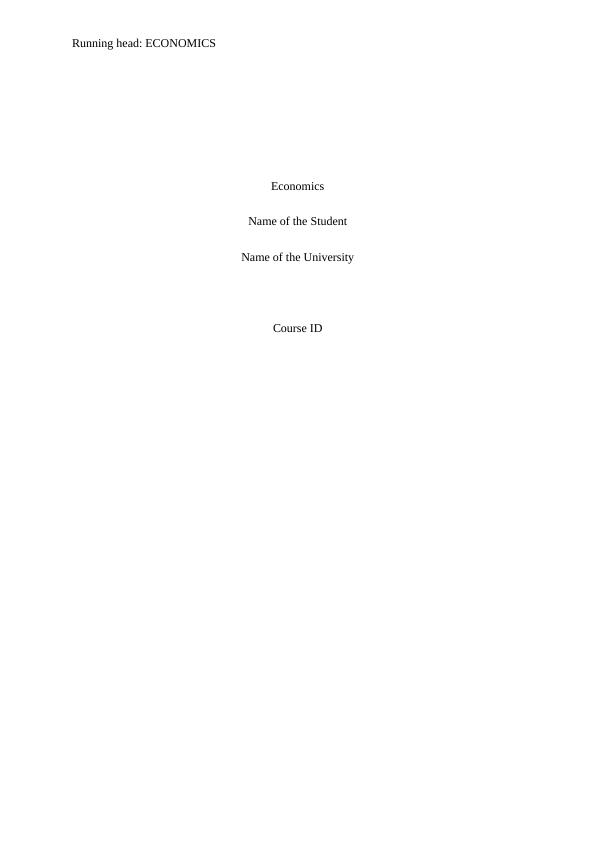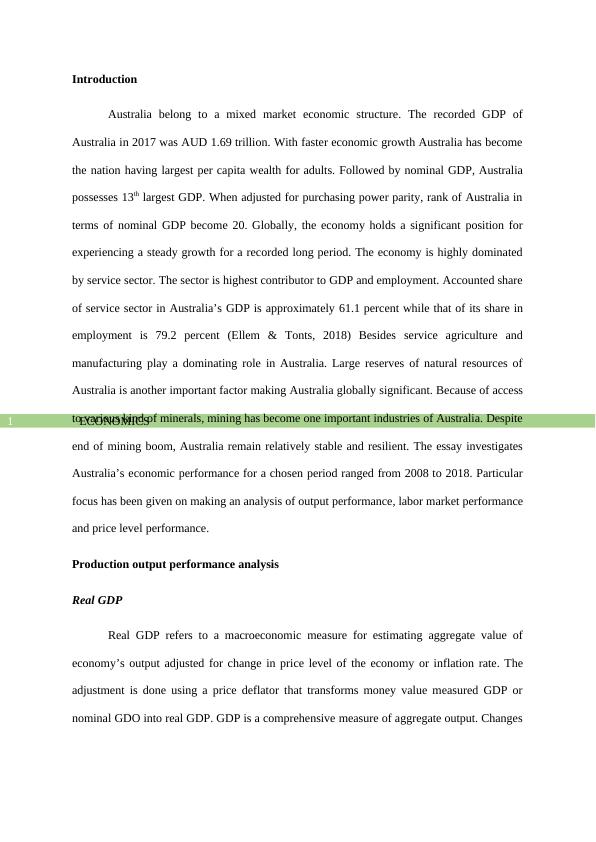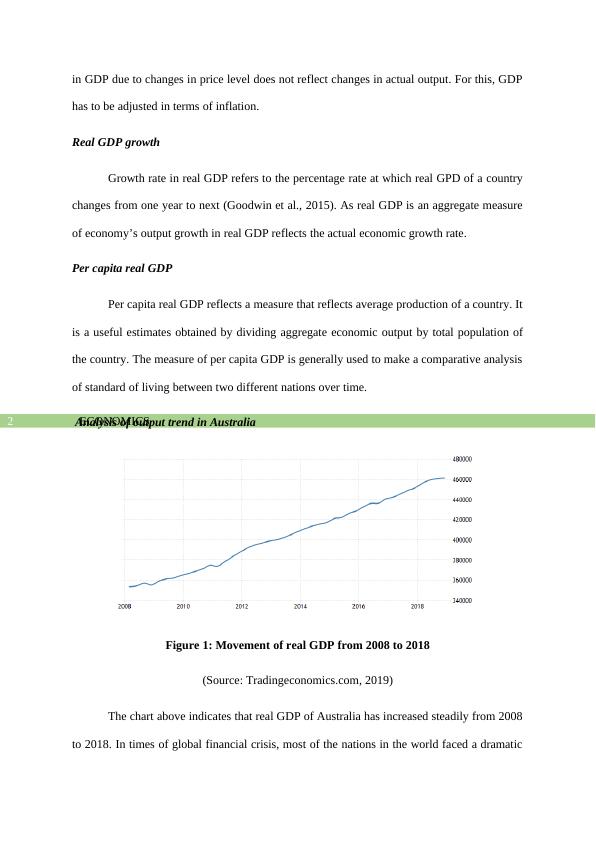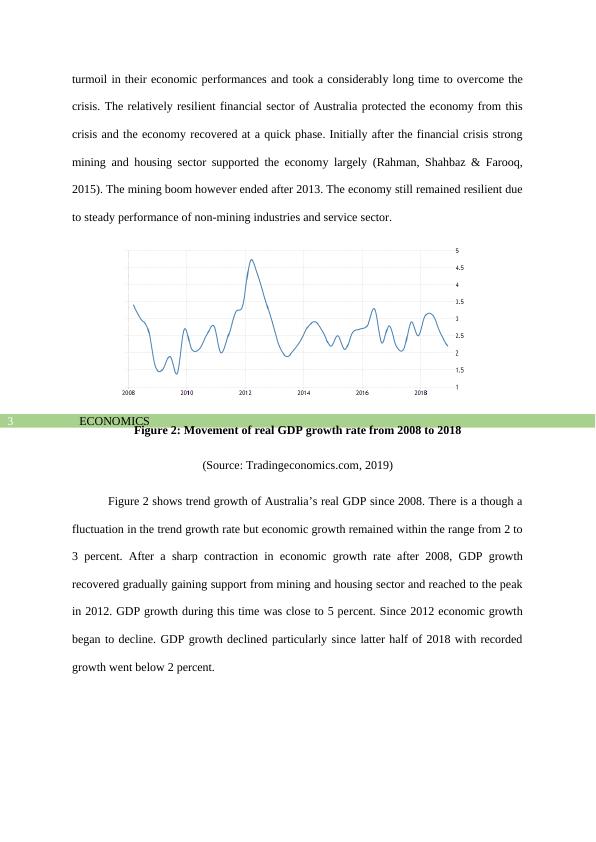Analysis of Australia's Economic Performance from 2008 to 2018
Added on 2022-10-19
14 Pages2836 Words314 Views
Running head: ECONOMICS
Economics
Name of the Student
Name of the University
Course ID
Economics
Name of the Student
Name of the University
Course ID

ECONOMICS1
Introduction
Australia belong to a mixed market economic structure. The recorded GDP of
Australia in 2017 was AUD 1.69 trillion. With faster economic growth Australia has become
the nation having largest per capita wealth for adults. Followed by nominal GDP, Australia
possesses 13th largest GDP. When adjusted for purchasing power parity, rank of Australia in
terms of nominal GDP become 20. Globally, the economy holds a significant position for
experiencing a steady growth for a recorded long period. The economy is highly dominated
by service sector. The sector is highest contributor to GDP and employment. Accounted share
of service sector in Australia’s GDP is approximately 61.1 percent while that of its share in
employment is 79.2 percent (Ellem & Tonts, 2018) Besides service agriculture and
manufacturing play a dominating role in Australia. Large reserves of natural resources of
Australia is another important factor making Australia globally significant. Because of access
to various kind of minerals, mining has become one important industries of Australia. Despite
end of mining boom, Australia remain relatively stable and resilient. The essay investigates
Australia’s economic performance for a chosen period ranged from 2008 to 2018. Particular
focus has been given on making an analysis of output performance, labor market performance
and price level performance.
Production output performance analysis
Real GDP
Real GDP refers to a macroeconomic measure for estimating aggregate value of
economy’s output adjusted for change in price level of the economy or inflation rate. The
adjustment is done using a price deflator that transforms money value measured GDP or
nominal GDO into real GDP. GDP is a comprehensive measure of aggregate output. Changes
Introduction
Australia belong to a mixed market economic structure. The recorded GDP of
Australia in 2017 was AUD 1.69 trillion. With faster economic growth Australia has become
the nation having largest per capita wealth for adults. Followed by nominal GDP, Australia
possesses 13th largest GDP. When adjusted for purchasing power parity, rank of Australia in
terms of nominal GDP become 20. Globally, the economy holds a significant position for
experiencing a steady growth for a recorded long period. The economy is highly dominated
by service sector. The sector is highest contributor to GDP and employment. Accounted share
of service sector in Australia’s GDP is approximately 61.1 percent while that of its share in
employment is 79.2 percent (Ellem & Tonts, 2018) Besides service agriculture and
manufacturing play a dominating role in Australia. Large reserves of natural resources of
Australia is another important factor making Australia globally significant. Because of access
to various kind of minerals, mining has become one important industries of Australia. Despite
end of mining boom, Australia remain relatively stable and resilient. The essay investigates
Australia’s economic performance for a chosen period ranged from 2008 to 2018. Particular
focus has been given on making an analysis of output performance, labor market performance
and price level performance.
Production output performance analysis
Real GDP
Real GDP refers to a macroeconomic measure for estimating aggregate value of
economy’s output adjusted for change in price level of the economy or inflation rate. The
adjustment is done using a price deflator that transforms money value measured GDP or
nominal GDO into real GDP. GDP is a comprehensive measure of aggregate output. Changes

ECONOMICS2
in GDP due to changes in price level does not reflect changes in actual output. For this, GDP
has to be adjusted in terms of inflation.
Real GDP growth
Growth rate in real GDP refers to the percentage rate at which real GPD of a country
changes from one year to next (Goodwin et al., 2015). As real GDP is an aggregate measure
of economy’s output growth in real GDP reflects the actual economic growth rate.
Per capita real GDP
Per capita real GDP reflects a measure that reflects average production of a country. It
is a useful estimates obtained by dividing aggregate economic output by total population of
the country. The measure of per capita GDP is generally used to make a comparative analysis
of standard of living between two different nations over time.
Analysis of output trend in Australia
Figure 1: Movement of real GDP from 2008 to 2018
(Source: Tradingeconomics.com, 2019)
The chart above indicates that real GDP of Australia has increased steadily from 2008
to 2018. In times of global financial crisis, most of the nations in the world faced a dramatic
in GDP due to changes in price level does not reflect changes in actual output. For this, GDP
has to be adjusted in terms of inflation.
Real GDP growth
Growth rate in real GDP refers to the percentage rate at which real GPD of a country
changes from one year to next (Goodwin et al., 2015). As real GDP is an aggregate measure
of economy’s output growth in real GDP reflects the actual economic growth rate.
Per capita real GDP
Per capita real GDP reflects a measure that reflects average production of a country. It
is a useful estimates obtained by dividing aggregate economic output by total population of
the country. The measure of per capita GDP is generally used to make a comparative analysis
of standard of living between two different nations over time.
Analysis of output trend in Australia
Figure 1: Movement of real GDP from 2008 to 2018
(Source: Tradingeconomics.com, 2019)
The chart above indicates that real GDP of Australia has increased steadily from 2008
to 2018. In times of global financial crisis, most of the nations in the world faced a dramatic

ECONOMICS3
turmoil in their economic performances and took a considerably long time to overcome the
crisis. The relatively resilient financial sector of Australia protected the economy from this
crisis and the economy recovered at a quick phase. Initially after the financial crisis strong
mining and housing sector supported the economy largely (Rahman, Shahbaz & Farooq,
2015). The mining boom however ended after 2013. The economy still remained resilient due
to steady performance of non-mining industries and service sector.
Figure 2: Movement of real GDP growth rate from 2008 to 2018
(Source: Tradingeconomics.com, 2019)
Figure 2 shows trend growth of Australia’s real GDP since 2008. There is a though a
fluctuation in the trend growth rate but economic growth remained within the range from 2 to
3 percent. After a sharp contraction in economic growth rate after 2008, GDP growth
recovered gradually gaining support from mining and housing sector and reached to the peak
in 2012. GDP growth during this time was close to 5 percent. Since 2012 economic growth
began to decline. GDP growth declined particularly since latter half of 2018 with recorded
growth went below 2 percent.
turmoil in their economic performances and took a considerably long time to overcome the
crisis. The relatively resilient financial sector of Australia protected the economy from this
crisis and the economy recovered at a quick phase. Initially after the financial crisis strong
mining and housing sector supported the economy largely (Rahman, Shahbaz & Farooq,
2015). The mining boom however ended after 2013. The economy still remained resilient due
to steady performance of non-mining industries and service sector.
Figure 2: Movement of real GDP growth rate from 2008 to 2018
(Source: Tradingeconomics.com, 2019)
Figure 2 shows trend growth of Australia’s real GDP since 2008. There is a though a
fluctuation in the trend growth rate but economic growth remained within the range from 2 to
3 percent. After a sharp contraction in economic growth rate after 2008, GDP growth
recovered gradually gaining support from mining and housing sector and reached to the peak
in 2012. GDP growth during this time was close to 5 percent. Since 2012 economic growth
began to decline. GDP growth declined particularly since latter half of 2018 with recorded
growth went below 2 percent.

End of preview
Want to access all the pages? Upload your documents or become a member.
Related Documents
The Economy of Australia - ECCON 101 - Economicslg...
|15
|2918
|63
economics. Contents. Introduction......................lg...
|13
|2736
|417
Economic Performance of Russia: Analysis of GDP, Unemployment, and Inflationlg...
|15
|2819
|37
Economics Assignment: Analysis of Singapore's Output, Labor Market and Price Level Performancelg...
|14
|2670
|175
Performance of USA Economy from 2008 to 2018lg...
|16
|3141
|43
Economic Performance of Singapore: Analysis of Production Output, Labor Market, and Price Levellg...
|14
|3247
|271
